
How to Set Up International Shipping on Shopify (2025 Guide)
Learning how to set up international shipping on Shopify is essential if you want to grow beyond your local market. Cross-border shopping is no longer a niche trend but the new normal. According to DHL’s 2025 E-Commerce Trends Report, 3 in 5 shoppers buy from retailers outside their home country, and the global cross-border market is forecasted to hit $4.81 trillion by 2032.
For Shopify merchants, that means huge growth potential if you can deliver internationally with confidence. International shipping allows even small stores to reach new audiences. That’s why in this article, we’ll cover:
- What you need before setting up international shipping on Shopify
- Step-by-step instructions to add shipping profiles, zones, and rates
- Best practices for managing duties, taxes, and costs
- How to troubleshoot common Shopify shipping problems
Let’s dive right in!
What You Need Before Setting Up International Shipping on Shopify
Before you can offer Shopify shipping worldwide, a few essentials need to be in place.
1. Products and markets you’ll sell to
Not every product is practical or even legal to ship internationally. Before you start, you should review your catalog and decide which items are suitable for global delivery. Bulky or fragile products may be costly to send, and some goods are restricted in certain countries.
Common product categories that usually can’t be shipped internationally include:
- Perishable goods: fresh food, dairy, meat, or anything with a short shelf life
- Hazardous materials: aerosols, flammable liquids, batteries, or chemicals
- Restricted items: weapons, explosives, or government-controlled products
- Oversized or heavy items: large furniture, gym equipment, or industrial machinery
- Fragile items: glassware, ceramics, or items easily damaged in transit
- Cultural or regulated goods: alcohol, tobacco, plants, seeds, or animal products, depending on destination laws
Once you know what you can ship, identify the key markets you want to target, for example, focusing on Europe, Asia, or worldwide shipping, depending on your business goals.
2. Carrier accounts and rate calculators
To set realistic shipping prices, you’ll need accounts with carriers that handle international delivery, such as DHL, UPS, or FedEx. Each carrier provides online calculators that allow you to estimate shipping costs based on package weight, size, and destination country.
By setting up these accounts in advance, you can:
- Get accurate real-time shipping quotes.
- Avoid undercharging or overcharging customers.
- Display precise international shipping rates at checkout.
- Build customer trust by showing transparent costs upfront.
This preparation ensures that your Shopify store provides dependable international shipping options while reducing the risk of unexpected costs or delivery complications.
3. Shopify plan requirements
Not all Shopify plans support advanced shipping features.
For instance, showing carrier-calculated rates at checkout is only available on the Advanced plan or higher.
For Grow plan, you can add this feature by either switching to yearly billing (automatically activated) or paying an additional monthly fee through Shopify Support.
This applies to carriers like USPS, FedEx, UPS, Canada Post, and other supported shipping providers that show real-time calculated rates during checkout.
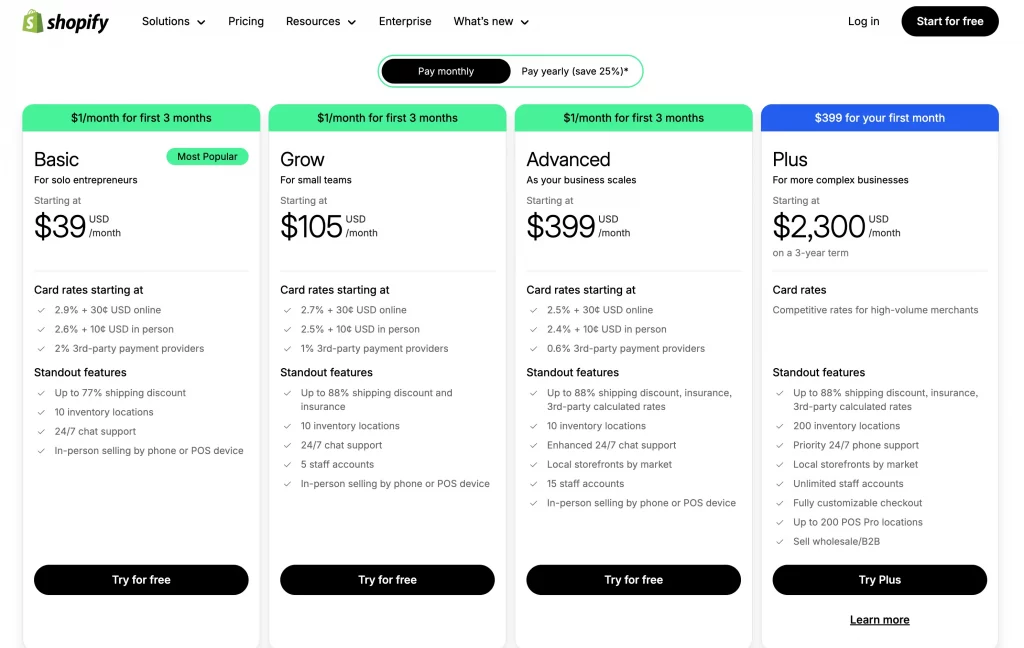
Shopify Markets, which lets you manage multiple countries and currencies, requires a plan upgrade for certain advanced features. Let’s check your current plan now so you don’t later discover that a feature you counted on isn’t available.
4. Common challenges merchants face
Shipping across borders comes with extra considerations that can affect both cost and customer experience. International delivery is often more expensive and takes longer than domestic shipping, so you’ll need to set expectations clearly.
Customs duties, import taxes, and paperwork can also create delays if not handled correctly. As you are aware, an upfront understanding of these challenges helps you prepare the right rates, policies, and communication for your customers.
How to Set Up International Shipping on Shopify
Once you’ve covered the basics, it’s time to configure your store. Follow these steps in your Shopify admin to create shipping profiles, add zones, set rates, and enable international markets.
Here’s the quick guide on how to set up international shipping on Shopify:
- Go to Settings > Shipping and delivery in your Shopify admin.
- Create or edit a shipping profile.
- Add an international shipping zone and select the countries you want to serve, then set up shipping rates (flat rate, free shipping, or carrier-calculated).
- Enable the countries in Shopify Markets.
- Test checkout to make sure international rates appear.
Now, let’s go to the detailed guide.
Step 1. Create or edit a shipping profile
From your Shopify admin, go to Settings > Shipping and delivery. Here you can either edit your existing shipping profile or create a new one if you want separate rules for certain products or locations.
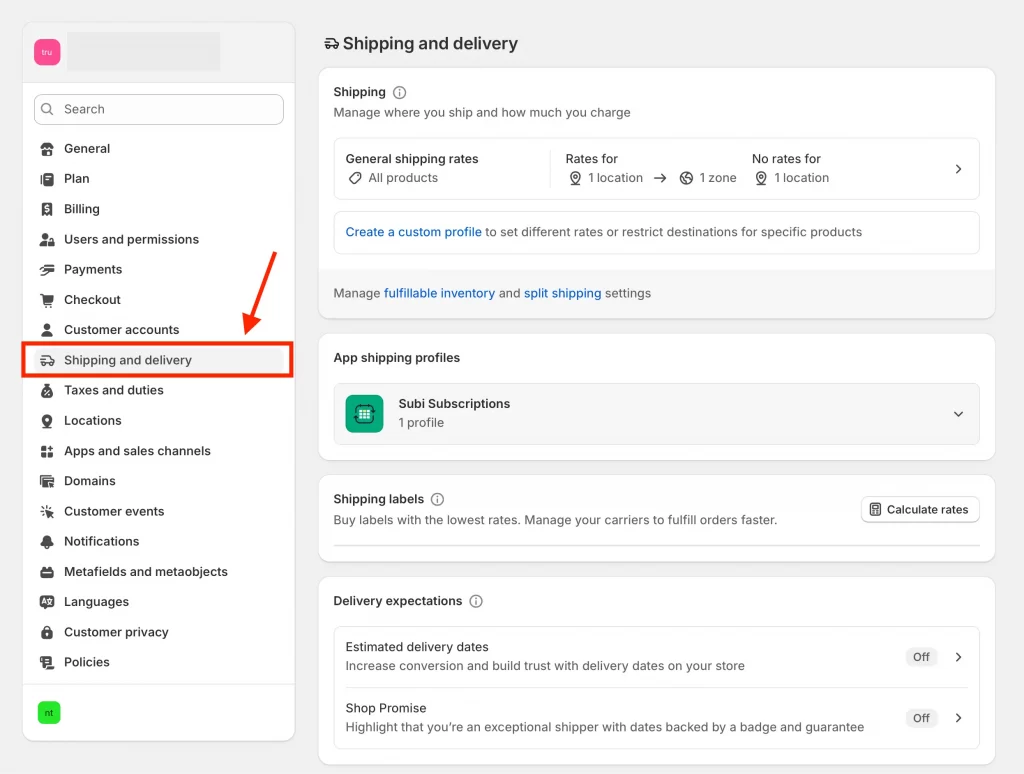
You can watch the Shopify tutorial video below for a full dashboard walkthrough of the shipping setup.
Shipping profiles act like containers for all your shipping zones and rates, so this is where the foundation of your international setup begins.
Step 2. Add an international shipping zone
In the Shipping section, click > (follow the image below) to get to the Shipping zones section.
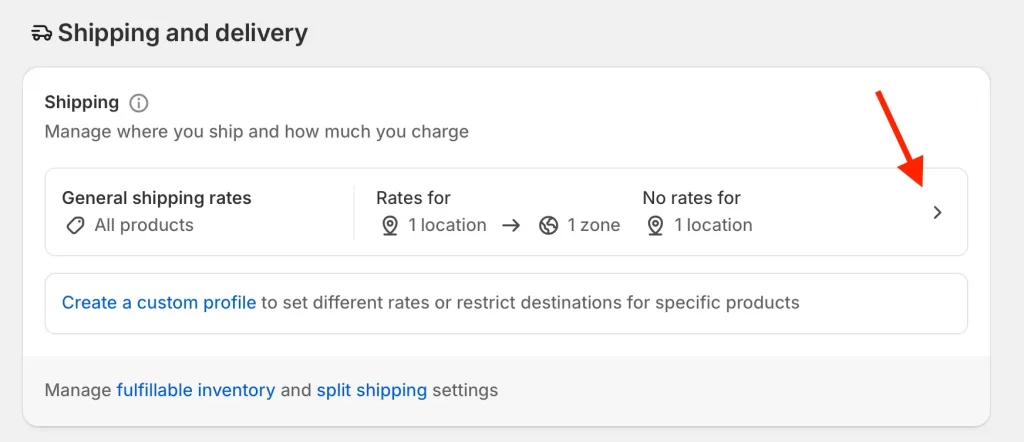
Now, click Add shipping zone.
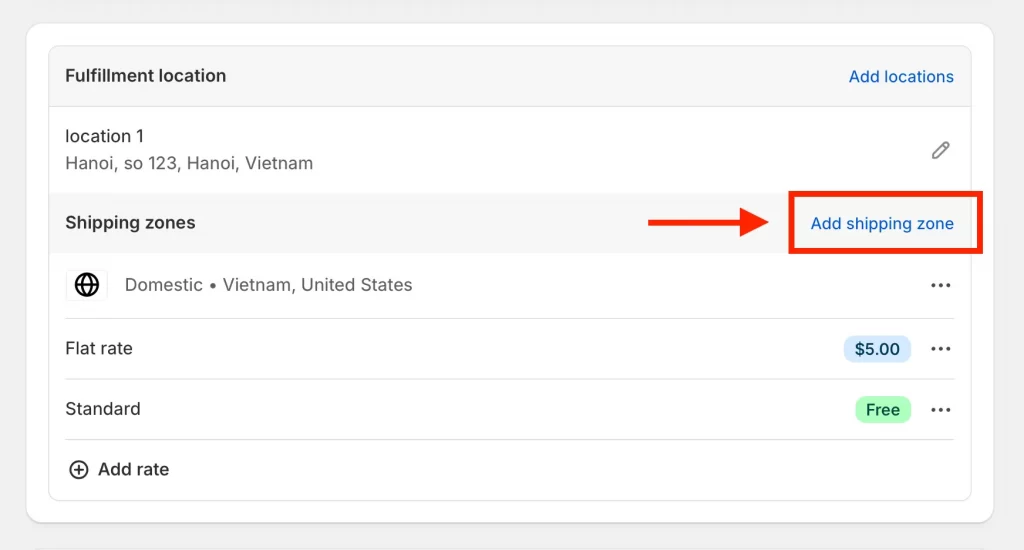
Give it a clear name (1), such as “Europe” or “Worldwide,” so you can easily manage it later. Select the countries you want to ship (2) to and click Done (3).
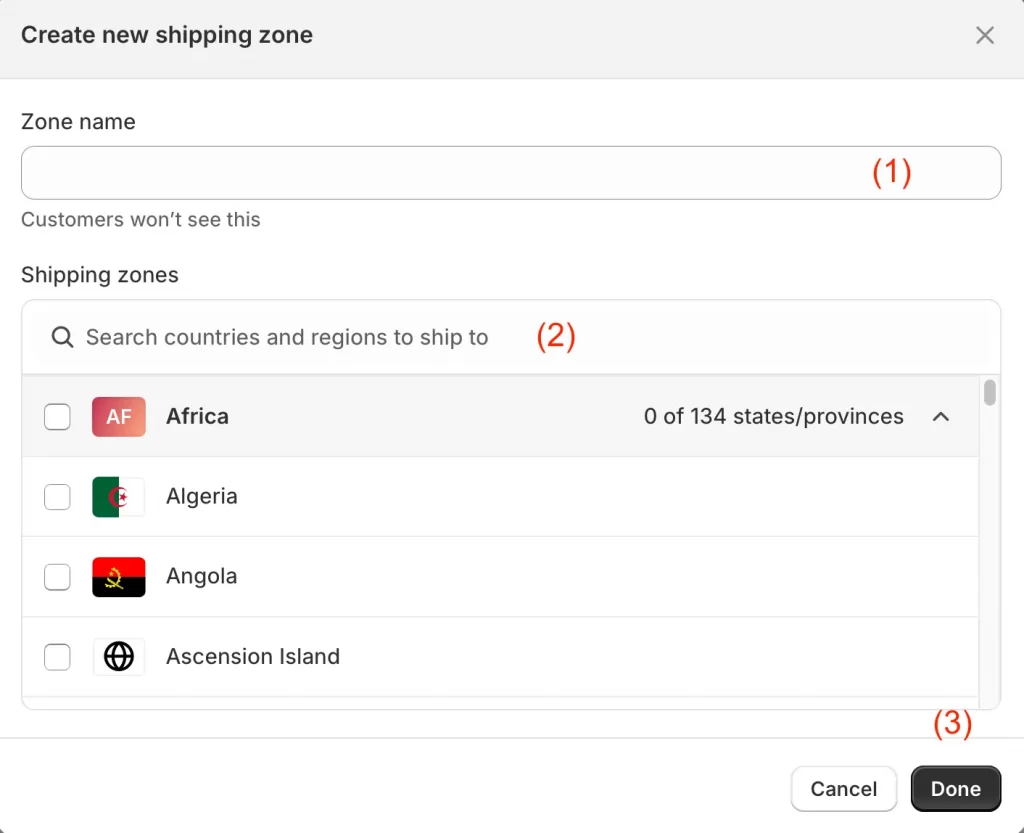
A shipping zone is essentially the map of where you’re willing to deliver, and each zone can have its own delivery methods in Shopify, shipping rates, and carrier options.
Step 3. Set up shipping rates for international zones
Once your new zone is created, you’ll need to decide how to set up international shipping rates on Shopify so customers see the right costs at checkout.
You can choose a flat rate (like $15 for all European orders), offer free shipping over a certain order amount, or use carrier-calculated rates through the Shopify shipping calculator if your plan allows it.
When you click Add rate, Shopify will give you options to set the rate type, add a custom name, and choose whether it’s free, flat-rate, or conditional.
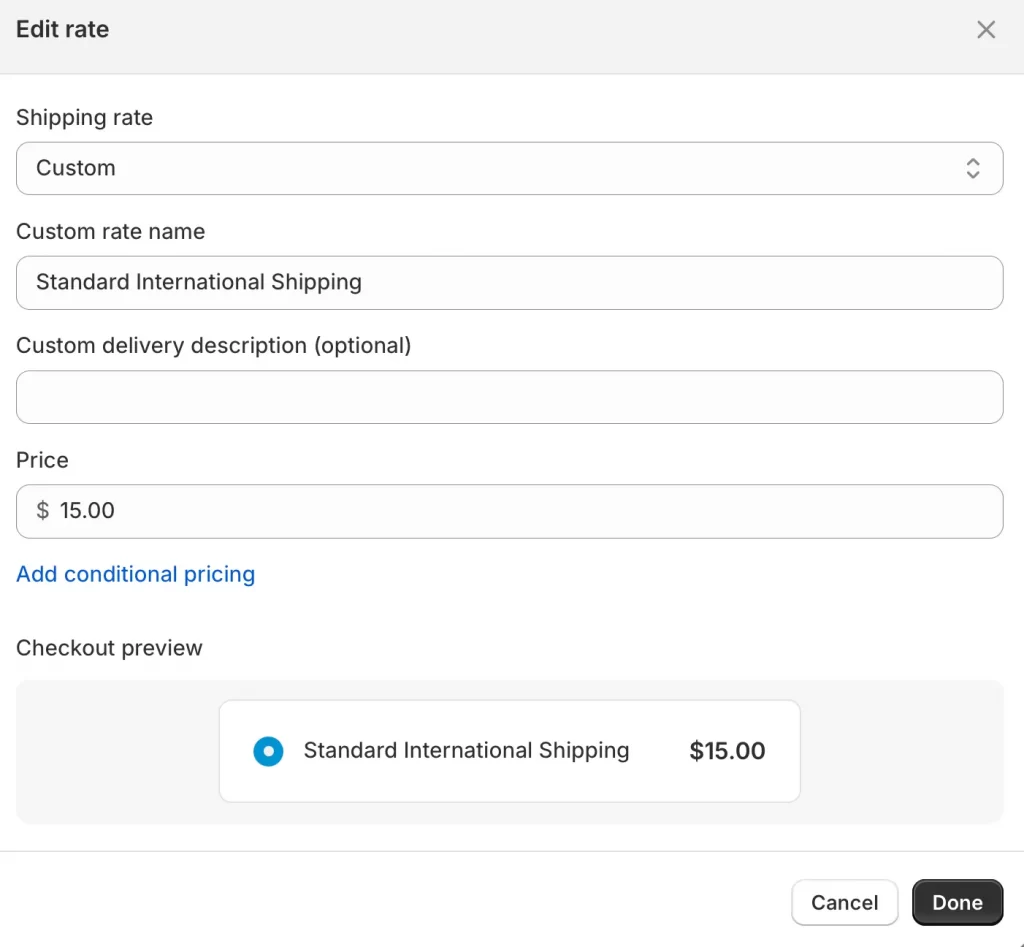
This screen is where you name your rate (for example “Standard International Shipping”), add an optional delivery description, and set the price customers will pay. The Checkout preview at the bottom shows exactly how it will appear to buyers.
Step 4. Enable international markets in Shopify
In your Shopify Admin dashboard, navigate to Markets and make sure the countries in your new shipping zone are included in an active market.

Without this step, customers from those regions won’t see shipping options when they check out. You can also adjust language, currency, and pricing here, which makes the shopping experience feel more local to your international customers.
Step 5. Test your international checkout
Before announcing global availability, you must run a test order as if you were a customer from another country. Let’s check that the correct rates appear, the checkout process works smoothly, and any duties or taxes are shown clearly. A quick test run helps you catch small mistakes early, instead of losing sales once customers start ordering.
Related post: How does Shopify shipping work?
Best Practices for Shopify International Shipping
Getting international shipping live is just the beginning. These best practices will help you reduce costs, build customer trust, and avoid common pitfalls when selling globally.
1. Be transparent with fees and delivery times
A store offering 7-10 day delivery with upfront duties collected at checkout consistently outperformed a store with “standard shipping” and no tax info. Even a short line like “Delivered in 8-12 business days, duties included” can boost trust.
Customers are more likely to complete a purchase when they know exactly what to expect. Show estimated delivery times and make it clear whether duties or taxes are included at checkout. This avoids surprises that could lead to abandoned carts or refund requests.
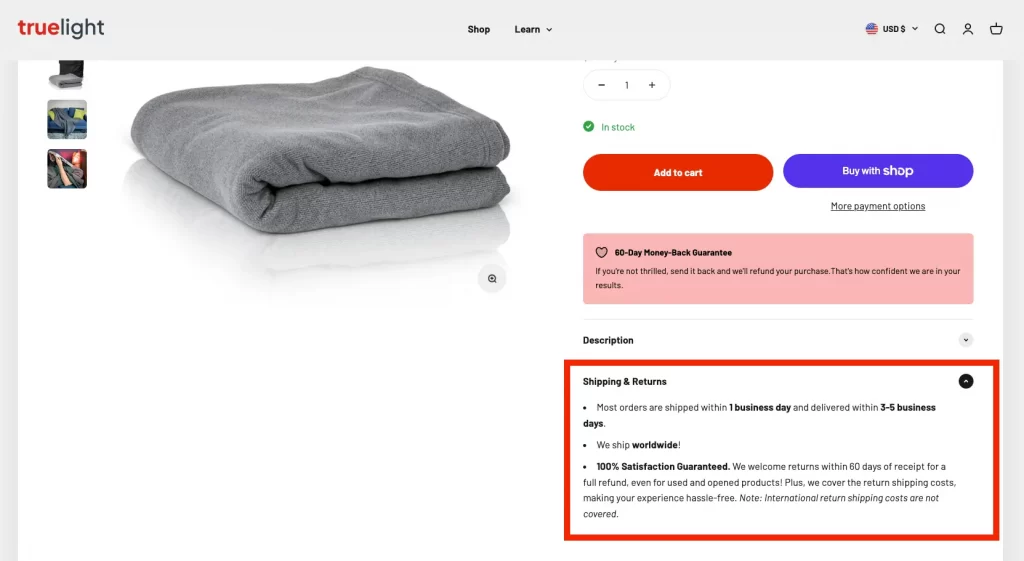
We saw this in action when working with TrueLight. As part of their international rollout, we implemented multi-currency support and clear shipping policies right on the product page. By making delivery windows and return rules transparent, the brand built more trust with overseas buyers and reduced checkout drop-offs.
2. Understand duties and taxes
Every country has its own import rules, and these can add extra costs to an order. Shopify lets you display duties and import taxes upfront so buyers aren’t caught off guard on delivery. Taking the time to set this up keeps your shipping process professional and builds trust with international customers.
3. Optimize packaging and costs
Smaller, lighter packages usually cost less to ship. We’ve worked with stores that cut 20-30% off shipping costs by switching from oversized boxes to flat-rate packaging. Beyond cost savings, well-packed orders also reduce damage claims, which is especially important when shipments travel across multiple carriers and borders. Many merchants also take advantage of Shopify shipping discounts to keep costs manageable as volume grows.
4. Consider shipping apps for advanced needs
If your store handles a large number of international orders or complex shipping rules, using an international shipping app like Easyship, ShipStation, or PH MultiCarrier can automate much of the work. They connect directly with your Shopify store to provide live rates, create labels, and track deliveries across multiple carriers.
Troubleshoot Common Problems with Shopify International Shipping
Even with the right setup, issues can come up during checkout or delivery. Here are the most common problems Shopify merchants face, along with quick solutions to resolve them.
1. Customers not seeing shipping options at checkout
If buyers from certain countries can’t select a shipping method, this issue usually comes from a missing connection between shipping zones and Shopify Markets. We recommend reviewing your Shipping and delivery settings to confirm the country is included in a zone, then checking Markets to make sure that the same country is active. You should always test with a dummy order to confirm customers can see the options before going live.
2. Countries missing from Markets
Sometimes a country is listed in your shipping zone but not activated in Shopify Markets. We recommend opening Markets and enabling the region there. Without this step, the zone won’t appear at checkout. At LitOS, we advise merchants to cross-check their shipping zones and Markets list side by side to avoid missing countries.
3. Unexpected costs for duties or taxes
Hidden customs fees are one of the fastest ways to lose international customers. We recommend enabling Shopify’s duties and import tax feature so costs are shown at checkout, alongside the correct Shopify shipping rates for each region.
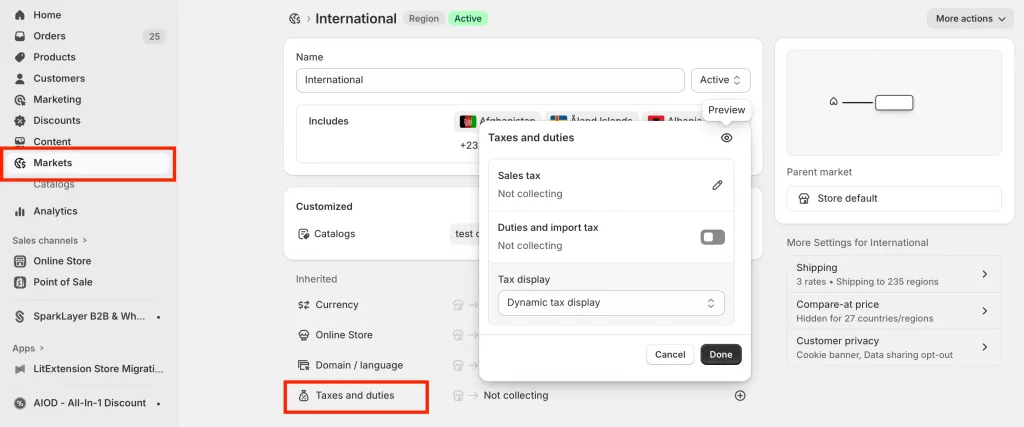
If your carrier supports DDP (Delivered Duty Paid), turn it on, as this ensures taxes are prepaid and packages aren’t held at customs. Our clients see much higher conversion rates when duties are transparent upfront.
How to Set Up International Shipping on Shopify: FAQs
How to activate international shipping on Shopify?
Go to Settings > Shipping and delivery, create a shipping zone for the countries you want to serve, add shipping rates, and make sure those countries are active in Settings > Markets.
How do I make my Shopify store international?
You can make your store international by enabling international markets, setting up shipping zones, and offering payment methods that support multiple currencies.
How to make international shipping cheaper on Shopify?
International shipping can be cheaper by using flat-rate shipping, choosing discounted carrier rates, or optimizing package sizes to reduce weight-based costs. Some merchants also compare Shopify UPS rates against other carriers to find the most affordable option.
Does Shopify have worldwide shipping?
Shopify itself doesn’t ship products, but it allows you to set up shipping rules so you can deliver to customers worldwide through your chosen carriers.
Final Words
And that’s the full guide on how to set up international shipping on Shopify today. With the right setup, you can open your store to customers worldwide, provide transparent shipping options, and grow your business with confidence in global markets.
Ready to ship worldwide with confidence?
At LitOS, we help Shopify brands expand beyond borders with smarter setups, streamlined shipping strategies, and hands-on support. From enabling your first international market to scaling global operations, we make going worldwide seamless and sustainable.
CONTACT US
